
Concept explainers
(a)
Interpretation:
The graph of the given data to form an oxygen-binding curve is to be plotted. The oxygen partial pressure at which the given hemoglobin is half-saturated is to be stated. Whether oxygen binding seems to be cooperative or not on the basis of the curve is to be stated.
Concept introduction:
Proteins are the
Answer to Problem 16P
The plot of the given data to form an oxygen-binding curve is shown below.
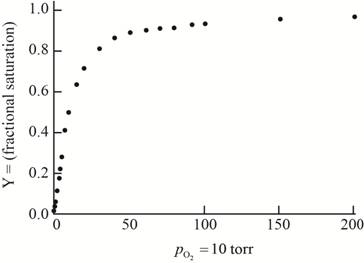
The oxygen partial pressure at which the given hemoglobin is half-saturated is
Explanation of Solution
On the basis of the given data for oxygen-binding for lamprey hemoglobin, the graph of fractional saturation versus partial pressure of oxygen is plotted as follows:
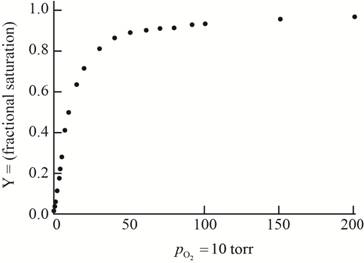
At the oxygen partial pressure,
Thus, this plot between partial pressure of oxygen
(b)
Interpretation:
A hill plot by using the given data is to be stated. Whether the hill plot shows any evidence for cooperativity or not is to be stated. The information about the hill coefficient is to be explained.
Concept introduction:
Proteins are the biomolecules which are composed of the long chain of amino acid residues. The protein which contains oxygen and is present in the red blood cells in the body is known as hemoglobin. It contains iron as well.
The hill equation indicates the two close equations which show the binding of a ligand with the macromolecule.
Answer to Problem 16P
A hill plot by using the given data is shown as,
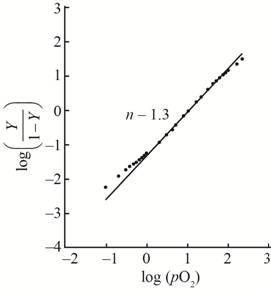
This plot show little bit cooperativity in the center of the curve and its hill coefficient is
Explanation of Solution
The equation that is used to show the hill equation is given as,
Here,
The values of
Similarly, for
The value of
Similarly, for
With the help of the given data for oxygen-binding for lamprey hemoglobin, the plot between
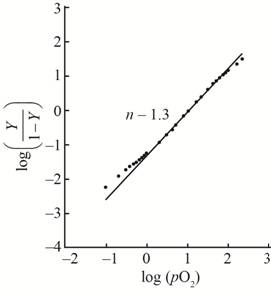
The value of slope
The hill coefficient for the graph is
(c)
Interpretation:
A model that is used to explain the observed cooperativity in oxygen binding by lamprey hemoglobin is to be stated.
Concept introduction:
Proteins are the biomolecules which are composed of the long chain of amino acid residues. The protein which contains oxygen and is present in the red blood cells in the body is known as hemoglobin. It contains iron as well.
Answer to Problem 16P
A model that is used to explain the observed cooperativity in oxygen binding by lamprey hemoglobin suggests that binding of oxygen with any monomer is easier as compared to binding of first oxygen with deoxygenated dimer.
Explanation of Solution
It is given that lamprey hemoglobin produces oligomers in the deoxygenated state. These oligomers were primarily dimmers in the deoxygenated state. These dimers are having low affinity for oxygen as compared to monomers. The cooperativity in oxygen binding is shown only if the dissociation of dimmers into two monomers occurs after the binding of first oxygen atom with a dimer. In this model, the binding of oxygen with every monomer is very easy as compared to the binding between first oxygen and the deoxy dimer.
Want to see more full solutions like this?
Chapter 7 Solutions
BIOCHEMISTRY W/1 TERM ACHEIVE ACCESS
- Draw the reaction between sphingosine and arachidonic acid. Draw out the full structures.arrow_forwardDraw both cis and trans oleic acid. Explain why cis-oleic acid has a melting point of 13.4°C and trans-oleic acid has a melting point of 44.5°C.arrow_forwardDraw the full structure of the mixed triacylglycerol formed by the reaction of glycerol and the fatty acids arachidic, lauric and trans-palmitoleic. Draw the line structure.arrow_forward
- Draw out the structure for lycopene and label each isoprene unit. "Where is lycopene found in nature and what health benefits does it provide?arrow_forwardWhat does it mean to be an essential fatty acid? What are the essential fatty acids?arrow_forwardCompare and contrast primary and secondary active transport mechanisms in terms of energy utilisation and efficiency. Provide examples of each and discuss their physiological significance in maintaining ionic balance and nutrient uptake. Rubric Understanding the key concepts (clearly and accurately explains primary and secondary active transport mechanisms, showing a deep understanding of their roles) Energy utilisation analysis ( thoroughly compares energy utilisation in primary and secondary transport with specific and relevant examples Efficiency discussion Use of examples (provides relevant and accurate examples (e.g sodium potassium pump, SGLT1) with clear links to physiological significance. Clarity and structure (presents ideas logically and cohesively with clear organisation and smooth transition between sections)arrow_forward
- 9. Which one of the compounds below is the major organic product obtained from the following reaction sequence, starting with ethyl acetoacetate? 요요. 1. NaOCH2CH3 CH3CH2OH 1. NaOH, H₂O 2. H3O+ 3. A OCH2CH3 2. ethyl acetoacetate ii A 3. H3O+ OH B C D Earrow_forward7. Only one of the following ketones cannot be made via an acetoacetic ester synthesis. Which one is it? Ph کہ A B C D Earrow_forward2. Which one is the major organic product obtained from the following reaction sequence? HO A OH 1. NaOEt, EtOH 1. LiAlH4 EtO OEt 2. H3O+ 2. H3O+ OH B OH OH C -OH HO -OH OH D E .CO₂Etarrow_forward
- what is a protein that contains a b-sheet and how does the secondary structure contributes to the overall function of the protein.arrow_forwarddraw and annotate a b-sheet and lable the hydrogen bonding. what is an example that contains the b-sheet and how the secondary structure contributes to the overall function of your example protein.arrow_forwardFour distinct classes of interactions (inter and intramolecular forces) contribute to a protein's tertiary and quaternary structures. Name the interaction then describe the amino acids that can form this type of interaction. Draw and annotate a diagram of the interaction between two amino acids.arrow_forward
 BiochemistryBiochemistryISBN:9781305577206Author:Reginald H. Garrett, Charles M. GrishamPublisher:Cengage Learning
BiochemistryBiochemistryISBN:9781305577206Author:Reginald H. Garrett, Charles M. GrishamPublisher:Cengage Learning BiochemistryBiochemistryISBN:9781305961135Author:Mary K. Campbell, Shawn O. Farrell, Owen M. McDougalPublisher:Cengage Learning
BiochemistryBiochemistryISBN:9781305961135Author:Mary K. Campbell, Shawn O. Farrell, Owen M. McDougalPublisher:Cengage Learning Human Heredity: Principles and Issues (MindTap Co...BiologyISBN:9781305251052Author:Michael CummingsPublisher:Cengage Learning
Human Heredity: Principles and Issues (MindTap Co...BiologyISBN:9781305251052Author:Michael CummingsPublisher:Cengage Learning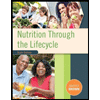 Nutrition Through the Life Cycle (MindTap Course ...Health & NutritionISBN:9781305628007Author:Judith E. BrownPublisher:Cengage Learning
Nutrition Through the Life Cycle (MindTap Course ...Health & NutritionISBN:9781305628007Author:Judith E. BrownPublisher:Cengage Learning Human Physiology: From Cells to Systems (MindTap ...BiologyISBN:9781285866932Author:Lauralee SherwoodPublisher:Cengage Learning
Human Physiology: From Cells to Systems (MindTap ...BiologyISBN:9781285866932Author:Lauralee SherwoodPublisher:Cengage Learning





